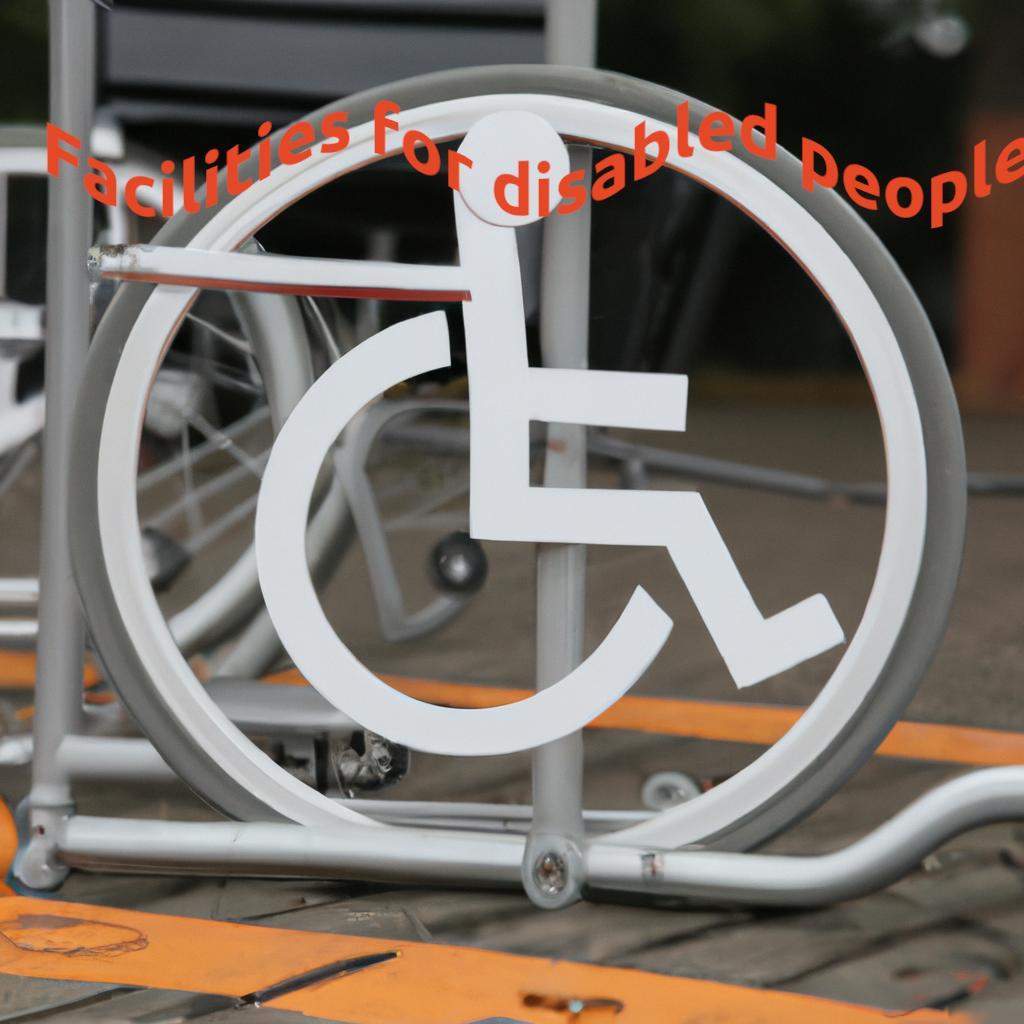


In the pursuit of inclusive urban environments, the scientific exploration of infrastructure for disabled people stands as a testament to progress and social equity. Researchers across various disciplines converge to design and implement solutions that transcend physical barriers, ensuring that individuals with disabilities can navigate, participate, and thrive in public spaces. From smart technologies to universal design principles, the scientific journey toward accessible infrastructure is a multidimensional quest for inclusivity, independence, and a more equitable society.
Universal Design: A Scientific Paradigm Shift
At the heart of the scientific exploration of infrastructure for disabled individuals lies the concept of universal design. Researchers in architecture, urban planning, and engineering collaborate to create environments that are inherently accessible to people of all abilities. Universal design principles focus on inclusivity from the outset, considering diverse needs and abilities in the planning and construction of buildings, public spaces, and transportation systems.
Intelligent Navigation: The Role of Smart Technologies
Advancements in smart technologies play a pivotal role in enhancing the accessibility of infrastructure. Scientific research delves into the integration of intelligent navigation systems, such as GPS-enabled apps and assistive technologies, to empower individuals with disabilities in wayfinding. Smart cities incorporate features like audible signals at crosswalks, tactile guidance paths, and real-time information updates to facilitate seamless navigation for visually impaired individuals.
Accessible Transportation: Beyond Physical Barriers
The scientific exploration of accessible infrastructure extends to transportation systems, addressing the unique challenges faced by individuals with disabilities in mobility. Research in transportation engineering focuses on designing accessible bus stops, train stations, and airports, incorporating features like ramps, elevators, and tactile information to ensure a smooth and dignified travel experience. Advances in inclusive vehicle design and smart transit systems further contribute to breaking down barriers in public transportation.
Inclusive Public Spaces: Beyond Compliance
Scientific studies in architecture and urban planning scrutinize the design of public spaces to go beyond mere compliance with accessibility standards. Researchers investigate how inclusive urban design, with features like level entryways, ample seating, and universally designed amenities, fosters a sense of belonging and participation for individuals with disabilities. The goal is to create public spaces that are not just accessible but inviting and enjoyable for everyone.
Assistive Technologies: Tailoring Infrastructure to Individual Needs
The marriage of infrastructure and assistive technologies is a burgeoning field of scientific inquiry. Researchers collaborate to develop and integrate assistive devices into public spaces, such as auditory wayfinding systems, touch-responsive information kiosks, and adaptive seating solutions. These technologies are designed to cater to a spectrum of disabilities, enhancing autonomy and fostering a more inclusive interaction with the built environment.
Human-Centered Design: Insights from User Experience
Scientific research in infrastructure for disabled individuals embraces a human-centered design approach. Insights from user experience studies and participatory design processes guide the development of inclusive infrastructure. Researchers engage directly with individuals with disabilities to understand their unique needs, preferences, and challenges, ensuring that infrastructure solutions are not only technically sound but resonate with the lived experiences of the end users.
Emergency Preparedness: Ensuring Safety for All
The scientific exploration of accessible infrastructure extends to emergencies. Researchers investigate how to make evacuation routes, emergency shelters, and communication systems inclusive and accessible for individuals with disabilities. This includes developing technologies that provide real-time information and assistance during emergencies, ensuring that everyone, regardless of ability, can navigate and respond to unforeseen circumstances.
Regulatory Frameworks: Catalysts for Change
Scientific inquiry is complemented by the development and evolution of regulatory frameworks that advocate for accessibility. Researchers collaborate with policymakers and advocates to shape and refine building codes, accessibility standards, and inclusive urban planning guidelines. This interdisciplinary collaboration ensures that the scientific advancements in accessible infrastructure are translated into tangible changes in regulations and standards.
Public transport plays an important role in providing access to transportation for people in cities and towns and can have a significant impact on the environment, economy, and quality of life of communities. However, for people with disabilities, using public transport can be challenging due to various physical and sensory barriers.
To address these challenges, many public transport systems offer specialized services and facilities to accommodate people with disabilities, such as:
Accessible vehicles: These are vehicles designed to accommodate people with disabilities, such as buses with wheelchair ramps, low floors, and securement systems.
Audio and visual information: This includes announcements, signs, and displays that provide information about the route, stops, and other relevant details for people with visual or hearing impairments.
Braille and tactile signage: These are signs and displays that use raised lettering or other tactile features to provide information for people with visual impairments.
Assistance from staff: Many public transport systems have trained staff members who can assist passengers with disabilities, such as helping them board or exit the vehicle, or providing directions and information.
Paratransit services: These are specialized transport services designed to provide door-to-door or curb-to-curb transport for people with disabilities who are unable to use regular public transport.
Priority seating: Many public transport systems reserve seating areas for people with disabilities, pregnant women, and seniors.
In addition, many countries have laws and regulations in place to ensure that public transport is accessible to people with disabilities, such as the Americans with Disabilities Act (ADA) in the United States and the Disability Discrimination Act (DDA) in the United Kingdom.
Making public transport accessible and inclusive for people with disabilities is an important step toward creating more equitable and sustainable communities.
There are no comprehensive global statistics on transport for disabled people, but here are some key statistics from various countries and regions:
United States: According to a 2017 report by the Bureau of Transportation Statistics, about 25 million people with disabilities use some form of public transport in the United States and over 3 million use paratransit services.
European Union: According to a 2016 study by the European Commission, about 42 million people with disabilities live in the European Union and many face barriers in accessing public transport.
United Kingdom: According to a 2019 report by the Department for Transport, about 13% of households in the UK include a person with a disability, and about 12% of public transport trips are made by people with disabilities.
Australia: According to a 2020 report by the Australian Bureau of Statistics, about 4.4 million people in Australia have a disability, and about 4.6% of all trips made on public transport are by people with disabilities.
Japan: According to a 2018 report by the Ministry of Land, Infrastructure, Transport and Tourism, about 4.4 million people in Japan have a disability, and the government provides subsidies and incentives to encourage transport operators to improve accessibility.
These statistics highlight the importance of accessible and inclusive transport for people with disabilities, and the need for continued efforts to address barriers and improve access to transportation services around the world.
In recent years, there have been several worldwide innovations in infrastructure for people with disabilities aimed at improving their mobility, access, and quality of life. Some of these innovations include:
Accessible Public Transportation: Many cities around the world have improved their public transportation systems to make them more accessible for people with disabilities. This includes the use of low-floor buses and trains, accessible stations, and audio and visual announcements.
Universal Design Buildings: Universal design is an approach to building design that aims to create environments that can be used by people of all abilities. This includes the use of wider doorways, ramps instead of stairs, and accessible bathrooms and kitchens.
Accessible Pedestrian Infrastructure: Many cities are making their pedestrian infrastructure more accessible for people with disabilities. This includes the installation of curb ramps, tactile paving, and audible crossing signals.
Assistive Technologies: There are many new assistive technologies that are helping people with disabilities to live more independently. For example, there are now smart home technologies that allow people to control their environment using voice commands, as well as mobility aids such as powered wheelchairs and prosthetics that are more advanced and adaptable than ever before.
Inclusive Playgrounds: In recent years, there has been a growing trend toward building inclusive playgrounds that can be used by children of all abilities. These playgrounds typically include equipment that is accessible to children with physical disabilities, as well as sensory play areas for children with autism and other sensory processing disorders.
There are many exciting innovations happening around the world that are aimed at improving the lives of people with disabilities. As technology continues to advance, we can expect to see even more advancements in this area in the coming years.
The scientific exploration of infrastructure for disabled individuals is an ongoing journey marked by innovation, collaboration, and a commitment to social inclusion. Researchers from diverse fields converge to dismantle physical and societal barriers, creating environments where accessibility is not an afterthought but a foundational principle. As the scientific community continues to advance our understanding of inclusive infrastructure, the path toward a more equitable and accessible world for individuals with disabilities becomes clearer, promising a future where everyone can fully participate, engage, and thrive in the built environment.
Sincerely yours,

We use cookies
We use cookies and other tracking technologies to improve your browsing experience on our website, to show you personalized content and targeted ads, to analyze our website traffic, and to understand where our visitors are coming from. Privacy Policy.